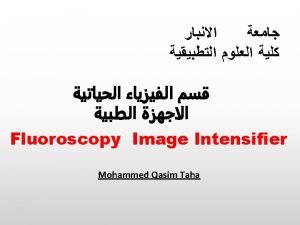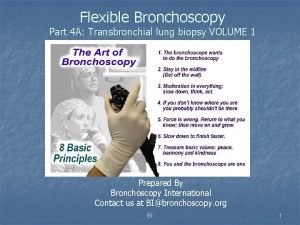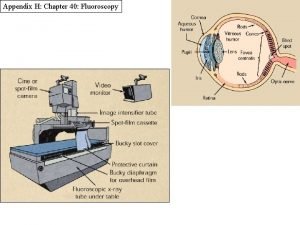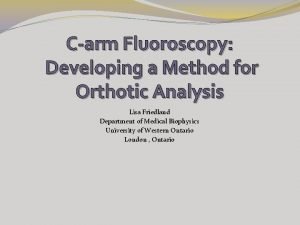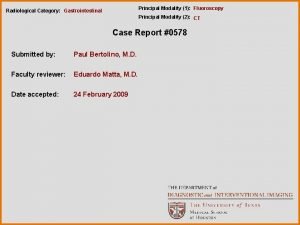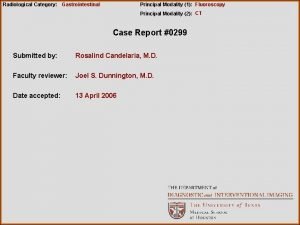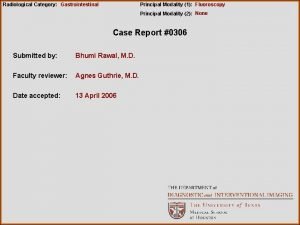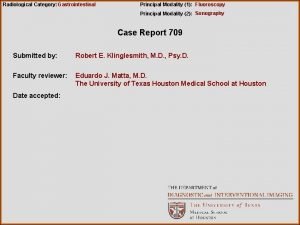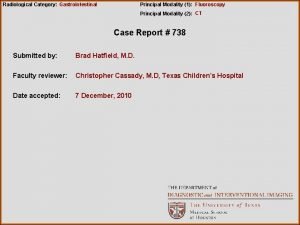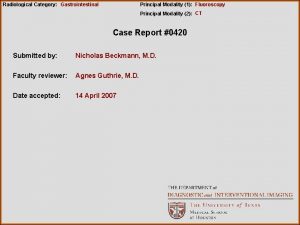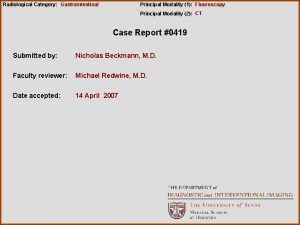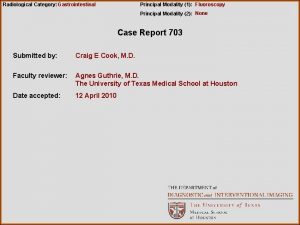Radiological Category Gastrointestinal Principal Modality 1 Fluoroscopy Principal






![Discussion Intramural esophageal pseudodiverticula are dilated excretory ducts of esophageal mucus glands [1]. It Discussion Intramural esophageal pseudodiverticula are dilated excretory ducts of esophageal mucus glands [1]. It](https://slidetodoc.com/presentation_image_h/046d440d349c6240cc96523fc5a71049/image-7.jpg)


- Slides: 9

Radiological Category: Gastrointestinal Principal Modality (1): Fluoroscopy Principal Modality (2): none Case Report #0605 Submitted by: Sarah Martaindale, M. D. Faculty reviewer: Verghese George, M. D. Date accepted: 11 April 2009

Case History 59 year old female with history of diabetes, hypertension, alcohol abuse, and longterm smoking. Upper GI series requested to evaluate for possible reflux.

Radiological Presentations

Radiological Presentations

Test Your Diagnosis Which one of the following is your choice for the appropriate diagnosis? After your selection, go to next page. • Esophageal Perforation • Zenker’s Diverticulum • Intramural Esophageal Pseudodiverticulosis • Infectious Esophagitis

Findings and Differentials Findings: The first image demonstrates a cluster of connected outpouchings filled with contrast, running parallel to the lumen. More distally a single outpouching is present. The second image, obtained after several swallows of contrast, demonstrated multiple small outpouchings, filled with contrast, as well as a hiatal hernia. Some of the contrast collections have no discernable connection to the esophagus. The contour of the esophagus is otherwise normal without filling defects or strictures. Differentials: • Esophageal diverticulum, including Zenker’s, epiphrenic, traction, and pulsion diverticula • Infectious esophagitis
![Discussion Intramural esophageal pseudodiverticula are dilated excretory ducts of esophageal mucus glands 1 It Discussion Intramural esophageal pseudodiverticula are dilated excretory ducts of esophageal mucus glands [1]. It](https://slidetodoc.com/presentation_image_h/046d440d349c6240cc96523fc5a71049/image-7.jpg)
Discussion Intramural esophageal pseudodiverticula are dilated excretory ducts of esophageal mucus glands [1]. It is thought to be caused by chronic inflammation from infection, gastroesophageal reflux, chronic alcohol abuse, and/or increased intralumenal pressure. There are often underlying esophageal lesions such as strictures, hiatal hernia with reflux, or long-standing candidiasis. The condition is not reversible, and even with treatment of the underlying cause, the pseudodiverticula remain [2, 3]. They are “flask-shaped” outpouchings and may be small tracks connecting the pseudodiverticula, which can be mistaken for perforation or ulceration [2]. Zenker’s diverticula are larger and just proximal to the UES, not in the location demonstrated in our case [1]. Infectious esophagitis, most commonly caused by Candida albicans, clinically presents with odynophagia, a symptom our patient did not have, and usually presents in patients who are immunocompromised [1]. Our patient does not have that history. On esophogram, there are both plaques causing filling defects and ulcerations. The appearance may be very similar to pseudodiverticulosis [3]. Perforation would present more acutely, and our patient did not have any history to suggest perforation.

Diagnosis Esophageal Pseudodiverticulosis with hiatal hernia

References 1. Brant WE. Pharynx and esophagus. In: Brant WE, Helms CA, ed. Fundamentals of Diagnostic Radiology. Philadelphia, PA: Lippincott Williams & Wilkins, 2007: 798 -815. 2. Gregor P, Nadir G, Haining S, Mathias L. Intramural Pseudodiverticulosis of the Esophagus. J Postgrad Medicine 2005; 51: 328 -29. 3. Tishler JM and Han S. Intramural Esophageal Pseudodiverticulosis. Dysphagia 1988; 2: 145 -148.
 Digital fluoroscopy vs conventional fluoroscopy
Digital fluoroscopy vs conventional fluoroscopy Erate category 2
Erate category 2 National radiological emergency preparedness conference
National radiological emergency preparedness conference Radiological dispersal device
Radiological dispersal device Tennessee division of radiological health
Tennessee division of radiological health Center for devices and radiological health
Center for devices and radiological health Real time fluoroscopy
Real time fluoroscopy Fluoroscopy bronchoscopy
Fluoroscopy bronchoscopy Spot film fluoroscopy
Spot film fluoroscopy Carm fluoroscopy
Carm fluoroscopy






